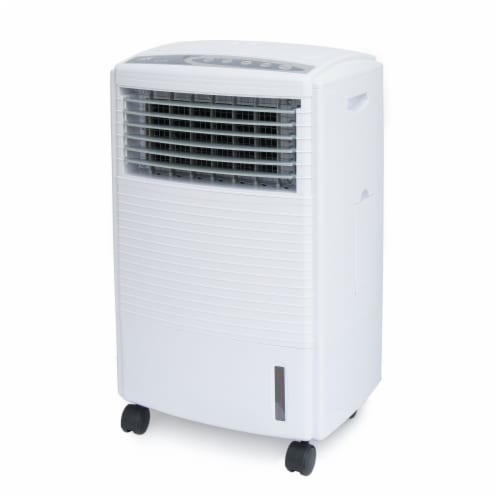Evaporative Air Cooler with Cooling Pad
-
Powerful Cooling: Experience a noticeable drop in temperature thanks to the unique 3D honeycomb cooling pad that maximizes airflow and evaporation. It's like having a portable cool zone wherever you go!Year-Round Comfort: Double as a humidifier in dry seasons and a gentle fan for year-round use. Breathe easy with cleaner, more comfortable air, no matter the weather.Energy Efficiency: Unlike traditional air conditioners, this cooler uses a fraction of the power (only 65W!), saving you money and helping the environment.Ultimate Convenience: Lightweight and portable with rolling wheels for effortless movement. Control everything effortlessly with the included remote control.Peace of Mind: Enjoy features like a 10L water tank for extended use, auto-swing louvers for even distribution, and a 3-speed fan for personalized comfort. Sleep soundly with the whisper-quiet sleep mode.
-
As a professional OEM Evaporative Air Cooler with Cooling Pad supplier and ODM Evaporative Air Cooler with Cooling Pad company, The evaporative wet curtain produced by the company has good water absorption and ventilation, strong cooling ability, long service life, and sterilization and algae prevention functions. It has been successfully applied in industrial plants with high-temperature operations such as evaporative air conditioners, evaporative cooling fans, humidifiers, animal husbandry, the greenhouse industry, the textile industry, hardware, as well as in public places such as shopping malls, internet cafes, supermarkets, etc., which can effectively improve indoor air quality, To prevent the spread of diseases caused by the use of air and truly achieve green environmental protection, energy conservation and emission reduction.
-
With the continued high temperatures of summer, Evaporative Air Coolers (commonly known as eco-friendly air conditioners) have become essential temperature control devices in many factories, workshops...
READ MORE -
In the fields of modern industrial ventilation and commercial cooling, Evaporative Air Coolers (commonly known as eco-friendly air conditioners or evaporative air coolers) are gradually becoming an id...
READ MORE -
In the hot summer, evaporative air coolers (commonly known as eco-friendly air conditioners or water-cooled fans) have become the preferred cooling equipment for many industrial plants, commercial spa...
READ MORE
Working principle of the water level indicator of Evaporative Air Cooler with Cooling Pad
1. Working principle of the water level indicator
a. Float design
Float principle: In many evaporative coolers, the water level indicator adopts a float design. The float is usually made of lightweight materials and can float on the water surface. When the water level rises, the float rises with it, and vice versa.
Mechanical trigger: The float is connected to a mechanical switch through a lever. When the float reaches a certain height, the lever triggers the switch to display the water level status to the user (such as through a pointer or indicator light). This design is simple and intuitive, and easy to maintain.
Water level indication: The movement position of the float is directly linked to the water level, and the user can understand the current water level by checking the indicator. For example, a red indicator light may mean that the water level is too high, while a green indicator light means that the water level is normal.
b. Electronic liquid level sensor
Sensor type: Some high-end coolers use electronic liquid level sensors, common ones are capacitive, ultrasonic and float sensors. Capacitive sensors monitor water levels by sensing changes in water conductivity, while ultrasonic sensors measure water level height by emitting sound waves.
Real-time monitoring: These sensors can monitor water level changes in real time and transmit information to the control system, providing more accurate water level data.
Digital display: Water level information is usually displayed in digital form on the device panel, and users can clearly see the water level status.
2. Mechanisms to prevent overfilling
a. Automatic stop of water inflow
Float control: In the float design, when the water level reaches the set highest point, the float rises to a certain height, triggering the control valve to close. This mechanism can automatically stop water inflow before the water level is too high to prevent overflow.
Electronic valve control: In the electronic liquid level sensor, when the water level is too high, the sensor will send a signal to the control system to automatically close the water inlet valve. This intelligent design improves the safety of the system.
b. Overflow drain
Design purpose: The overflow drain is another important design to prevent the water tank from being overfilled. It allows excess water to flow out automatically when the water level is too high, preventing water from overflowing outside the equipment.
Position setting: The overflow port is usually located on the top or side of the water tank to ensure that the water can be discharged smoothly when the water level exceeds the safety line.
c. Alarm system
Sound and light alarm: Some equipment is also equipped with a sound and light alarm system. When the water level is close to being overfilled, the system will sound an alarm to remind the user to deal with it in time to avoid overfilling.
User prompts: The alarm system is usually combined with the control panel to provide users with intuitive visual or auditory prompts.
 CONTACT US
CONTACT US English
English 中文简体
中文简体 عربى
عربى Tiếng Việt
Tiếng Việt









